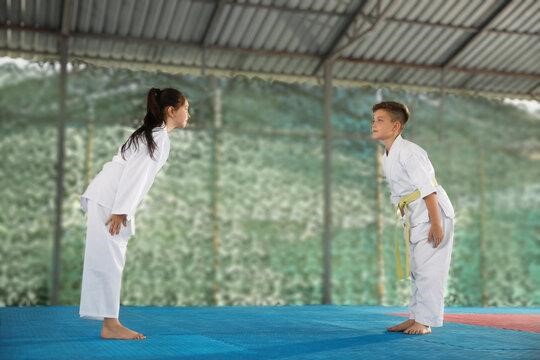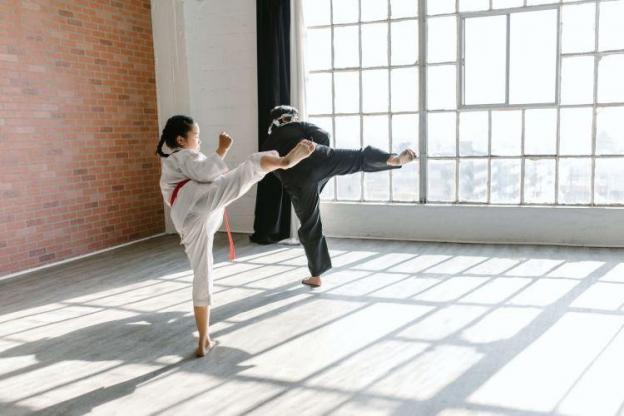MARTIAL ARTS – Help Kids and Heal Trauma
At 17 years old I began my journey with martial arts. At 18, I felt joy because I felt safe in my body for the first time; I was beginning to heal from my past trauma. By the time I turned 19, I was sharing my love for martial arts by teaching others.
Martial Arts focuses on self discipline, personal growth, AND physical movements.
My teacher once said,
“The journey from white to black belt was like a baby forming in the womb, we gather all the nutrients we need to become whole and then we emerge as our own person. Birth in this story was getting your black belt, and the lesson is two fold. The first is that the journey to black belt is as much an inward journey as it is physical. And the second lesson – achieving black belt is just the beginning.”

Do I recommend martial arts training for kids?
Yes, I would get kids into a dojo (martial arts gym) as soon as possible. There are numerous benefits to martial arts training beyond discipline.
Training in martial arts focuses on the self; it’s very personalized, and can also be very empowering. Martial Arts is inwardly focused and highly structured yet a safe and fun environment. It can be beneficial for all kids and adults, especially those with attention issues, depression, anxiety, C-PTSD/PTSD, and conduct disorders (all symptoms of a dysregulated nervous system).
There may be some focus on competition, however, a quality dojo will offer more emphasis on self mastery (How do I get better today than I was yesterday?). In fact, a good sensei (instructor) will encourage you against competition or showing off. The mantra is “I keep getting better and better” rather than “Someone is better than me”.
What does the nervous system need to be well regulated?
Meditation in Motion
Martial arts helped me know myself and fully inhabit my body. It was my introduction to breathwork, visualization and moving meditation. A major pillar in martial arts are the forms (katas) where a sequence of moves is choreographed and practiced repeatedly, similar to a dance routine. One such kata I practiced was ‘Sanchin’ which means meditation in motion; it focuses on marrying the breath with slow and controlled movements.
Visualization
What a moment to behold; seeing a child’s look of pride after overcoming fears and limiting beliefs to break a giant brick with their tiny foot! While training for that moment, students would kick a shield leaned against a wall. Students were instructed to kick through the shield. “Visualize your foot going all the way through the vinyl and stuffing and out the other side!” This visualization became a mantra for students as they prepared to do something they previously thought was impossible.
Emotional Regulation and Stress Management
Martial Arts training is great for people with anger issues. Often what is underneath anger is fear. Other times it can be lack of stress tolerance (Example: “My nervous system is such a wreck because I have no flexibility at all and will become highly reactive to small stressors because I move through my day consistently on edge.”) Whether we need to cultivate a sense of personal safety, manage stress, or have an outlet for the emotions we are holding in, martials arts can be hugely helpful.
Safety & Movement
Martial arts is a healing modality. Trauma can take root when we experience stressful events in which we are not able to fight back, escape, or just move our body in a way that we want at the time. When trauma occurs it can be stored in the body. Mindful, safe, embodied movement (engaging in the movement and behaviors that were not available to you in the moment) is one of the best ways to allow the body to ‘finish the circuit’ and heal the trauma pathway in the brain. Healing allows the body to let go because the pattern of movement that was initiated in the brain has now been allowed to be carried out by the body.

Mindfulness
Martial arts can teach mindfulness to people who can’t (or don’t want to) slow down. Practice brings awareness to our breath, our muscles, our body movements, movement and position of others in a fun, safe environment. We have the opportunity to participate as part of a community. Co-regulation (pleasant interactions between you and members of your community) is essential for healthy nervous system tone. *Tone or flexibility of the nervous system refers to its ability to move from a stress state to a calm/rest & digest state. The more tone, or flexible, the Vagus Nerve, the more ease with which the nervous system resets.
Why do I love the practice of martial arts?
I love martial arts because of the richness and layers of meaning to everything. In order to perform well in this sport, the student must be present, mindful, aware of themself and their surroundings. The unspoken gift is to feel at home in our bodies, moving through the world with more confidence because we can trust that we can defend ourselves. We learn we are safe in our body. Workouts are generally low impact and highly effective at improving balance and strength.
FIND A DOJO NEAR YOU AND START YOUR JOURNEY
Written by Kelly Price-Brewer

